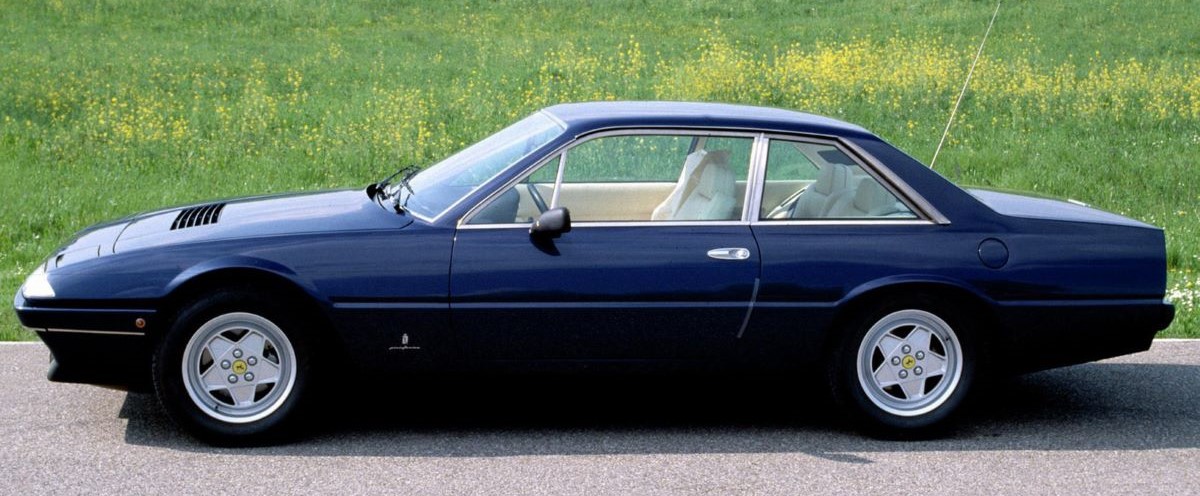
The 412 replaced the 400i and introduced a series of improvements, the most noticeable being the higher boot line, along with a deeper front spoiler to improve the car’s aerodynamics. Pininfarina’s other interventions included re-designed sill panels, body-coloured bumper inserts, a modified alloy wheel design, clear indicator lenses and black windscreen and window surrounds.
The V12 engine was bored out to 4,942 cc (from 4,823) with a corresponding 8% increase in power (to 340 bhp) and a 9.5% increase in torque for a 0-62 mph time of 6.7 seconds, and a standing quarter mile of 14.6 seconds compared to 14.8 for the 400i. The 412 was also the first Ferrari to offer Bosch ABS as standard.
In the Spring of 1985 the final evolution of the Pininfarina designed 2+2 series, that had started with the 365 GT4 2+2 in 1973, was introduced, with the presentation of the 412 model at the Geneva Salon. The 412 model designation referred to the swept volume of a single cylinder, thus the V12 engine had been increased in size to 4943cc, by providing a 1mm larger diameter bore of 82mm allied to the same 78mm stroke, producing a claimed 340 bhp at 6000rpm. As with the preceding 400i series cars it was fitted with fuel injection, and was available either with a five speed manual gearbox or a three speed automatic transmission. However, on this model there was no external badging to denote that a car was automatic, the tail badge stated simply 412, whichever gearbox was fitted. The engine type reference numbers were to F 101 E 070 and 010, with chassis type numbers F 101 EL 170 and 110, for the automatic and manual examples respectively.
At a glance it appeared very similar to a 400 series car, but closer inspection revealed a different road wheel design, that covered an ABS braking system as standard, the first roadgoing Ferrari so equipped. Apart from this the mechanical layout and elements were very similar to its predecessors. Viewing the body more closely showed a revised rear wing line providing a less pronounced slope to the tail, with a raising of the boot lid line, which had the benefit of increasing the luggage capacity. The bumpers of the 412 were body colour coded, and the door mirror design was a larger more rectangular profile than that of the last 400i models, without the small enamel Ferrari shield. Internally the seat design altered, along with the control layout on the centre console. Like the 365 GT4 2+2, and the 400 series, right or left hand drive power assisted steering was available, and again there was no USA market version. Similarly, the bodies were constructed at the Pininfarina factory in Turin, with the fully trimmed shells shipped to Ferrari for fitment of the mechanical components.
Production of the 412 ceased in 1989, bringing to an end a sixteen year run for what was essentially a single body style. This was the longest production run in the company’s history, during which time nearly three thousand examples were produced in total of the various types. A total of 576 examples of the 412 model were produced during the production run, in the chassis number range 56275 to 82153. It would be another three years before a 2+2 model reappeared in the Ferrari range catalogue, with the 456 GT, and nearly seven years before automatic transmission would once again become available on a Ferrari.

Specifications and Features
Engine
- Type………………………….front, longitudinal 60° V12
- Bore/stroke………………..82 x 78 mm
- Unitary displacement….411.92 cc
- Total displacement……..4943.03 cc
- Compression ratio……….9.6 : 1
- Maximum power………..250 kW (340 hp) at 6000 rpm
- Power per litre……………69 hp/l
- Maximum torque……….451 Nm (46 kgm) at 4200 rpm
- Valve actuation………….twin overhead camshafts per bank, two valves per cylinder
- Fuel feed…………………..Bosch K-Jetronic mechanical injection
- Ignition…………………….Marelli Microplex electronic, single spark plug per cylinder
- Lubrication………………..wet sump
- Clutch……………………….automatic: torque converter; / manual: twin-plate
Chassis
- Frame………………………tubular steel
- Front suspension……….independent, unequal-length wishbones, coil springs over telescopic shock absorbers, anti-roll bar
Rear suspension………..self-levelling, independent, unequal-length wishbones, twin coil springs over telescopic shock absorbers
Brakes………………………discs
Transmission……………automatic: 3-speed + reverse; / manual: 5-speed + reverse
Steering……………………rack-and-pinion
Fuel tank………………….capacity 120 litres
Front tyres………………..240/55 VR 16
Rear tyres…………………240/55 VR 16Bodywork
- Type……………………….2+2 coupé
- Length…………………….4810 mm
- Width………………………1798 mm
- Height……………………..1314 mm
- Wheelbase………………..2700 mm
- Front track……………….1480 mm
- Rear track…………………1500 mm
- Weight…………………….1810 kg; (dry) automatic / 1805 kg (dry) manual
Performance
- Top speed…………………automatic: 245 km/h; | manual: 250 km/h
- Acceleration
0-100 km/h……………….automatic: 8.3 sec; | manual: 6.7 sec
0-400 m……………………automatic: 15.2 sec; | manual: 14.6 sec
0-1000 m………………….automatic: 27.7 sec; | manual: 26.4 sec

You must be logged in to post a comment.